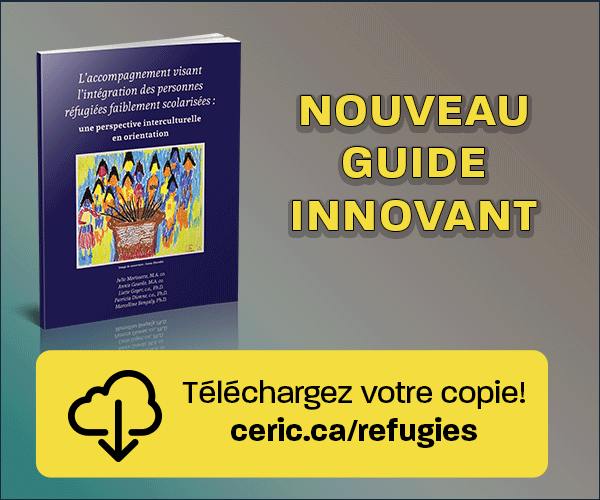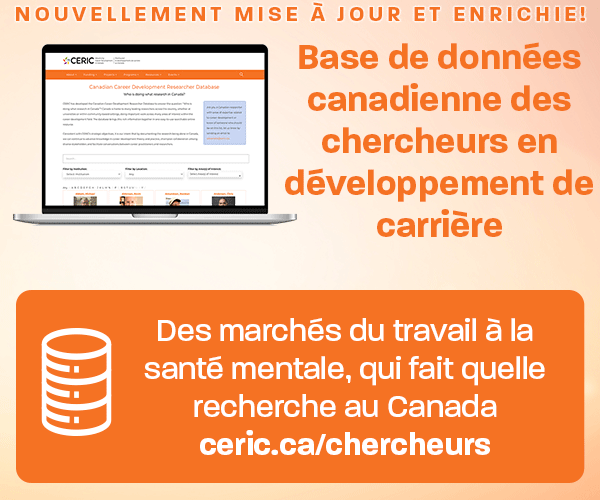Rédaction d’une autobiographie : est-ce une méthode efficace pour la réorientation professionnelle? Un rapport sur la recherche
Mots-clés :
changement de carrière, écrire, carrière, enquête, histoire de vieRésumé
Thousands of individuals may choose to change careers but due to changing social and economic factors millions will be forced to endure unplanned transitions in situations where they have little or no control over their career decisions. Brown et al (2003) conducted a meta-analysis of 62 career intervention studies involving a total of 7725 participants and concluded that writing exercises were the number one ingredient for effective career choices. However, this study did not distinguish between different kinds of writing exercises or methods, such as narrative-based interventions, which use creative, expressive, and reflective writing in career guidance (Lengelle, 2014). While the theory and methods of narrative-based interventions is well established in the field of career development, research and evidence to support their efficacy for career change is only beginning. To help close this gap, I designed an online survey that was completed by 44 individuals who used a life-story writing process for guiding their career change and a control group that attempted career change with nonwriting narrative tools. Results of this study indicate a positive correlation between the intent of life-story writing to ‘uncover’ a personal story, create a new career identity and facilitate a positive career change.
Références
Amundson, N. E., Harris-Bowlsbey, J., & Niles, S. G. (2012). Essential elements of career counseling: Process and techniques (3rd ed.). Upper Saddle River, NJ: Pearson Education.
Blustein, D.L. (2006). The psychology of working: A New Perspective for Career Development, Counseling, and Public Policy. New York: Routledge
Brown, S., Ryan-Krane, N., Brecheisen, J., Castelino, P., Budisin, I., et al. (2003). Critical ingredients of career choice interventions: More analyses and new hypotheses.
Journal of Vocational Behavior, 62, 411-428
Bruner, J. (1995) “The Autobiographical Process.” Current Sociology, 43.2: 161–177. Bureau of Labor Statistics (2010), U.S. Government. See the tables at:www.bls.gov/nls/nlsy79r24jobsbyedu.pdf
Corsini, R.J. & Wedding, D. (Eds.). (2014). Current Psychotherapies, 8th Edition. Toronto, ON: Nelson Education
Gelatt, H. B. & Gelatt, C. (2003). Creative Decision Making Using Positive Uncertainty (2nd ed.). Menlo Park, CA: Crisp Learning.
Lapointe, K. (2010). Narrating career, positioning identity: Career identity as a narrative practice. Journal of Vocational Behavior, 77, 1-9
Law, B., Meijers, F. & Wijers, G. (2010). New persepectives on career and identity in the contemporary world. British Journal of Guidance & Counselling, 30(4), 431-449.
Lengelle, R. (2014). Career writing, creative, expressive, and reflective approaches to narrative and dialogical career guidance (Published doctoral dissertation). Tilburg, The Netherlands: Tilburg University.
Lengelle, R., & Meijers, F. (2014). Narrative Identity: Writing the self in career learning. British Journal of Guidance and Counselling, 42(1), 1-21. DOI: 10.1080/03069885.2013.816837
Lengelle, R., Meijers, F., Poell, R., & Post, M. (2013). The effects of creative, expressive, and reflective writing on career learning: An explorative study. Journal of Vocational Behavior, 83(3), 419- 427
Lengelle, R., Meijers, F., Poell, R., & Post, M. (2014). Career Writing: Creative, expressive, and reflective approaches to narrative identity formation in students in higher education. Journal of Vocational Behavior, 85, 75-84
McAdams, D.P. (1993) The stories we live by: Personal myths and the making of the self. London: The Guilford Press.
Mitchell, K. E., Levin, A. S., & Krumboltz, J. D. (1999). Planned happenstance: Constructing unexpected career opportunities. Journal of Counseling and Development, 77(2), 115-125. doi:10.1002/j.1556-6676.1999.tb02431.x
Pryor, R. G. L., & Bright, J. E. H. (2005). Chaos in practice: Techniques for career counsellors. Australian Journal of Career Development, 14(1), 18-29. doi:10.1177/103841620501400105
Savickas, M.L. (2005). The theory and practice of career construction. In S. D. Brown & R. W. Lent, (Eds.), Career development and counselling: Putting research and theory to work (pp.42-69).
Hoboken, NJ: John Wiley & Sons Schlossberg, K. N. (1981). A model for analyzing human adaption to transition. The Counselling Psychologist, 9, 2-18.
Doi:10.1177/001100008100900202
Spicer, N. (2004). Combining qualitative and quantitative methods. In C. Seale (Ed.), Researching Society and Culture (2nd ed.) (pp. 293-303). London, UK: SAGE Publications
Stebleton, M. J. (2010). Narrativebased career counseling perspectives in times of change: An analysis of strengths and limitations. Journal of Employment Counseling, 47(2), 64-78.
Super, D. E., Savickas, M. L., & Super, C. M. (1996). The lifespan, life-space approach to careers. Career choice and development: Applying contemporary theories to practice (pp. 121-178). San Francisco: JosseyBass.
Vilhjalmsdottir, G., & Tulinius, T. (2009). Tales of two subjects: Narratives of career counselling. Journal of Vocational Behavior, 75, 267–274.
White, M. & Epson, D. (1990). Narrative means to therapeutic ends. New York: W.W. Norton
Winslade, J. (2005). Governing the self through the construction of a career narrative. Perspectives in Education, 23, 1-8.

Téléchargements
Publié-e
Comment citer
Numéro
Rubrique
Licence

Cette œuvre est sous licence Creative Commons Attribution - Pas d'Utilisation Commerciale - Pas de Modification 4.0 International.











